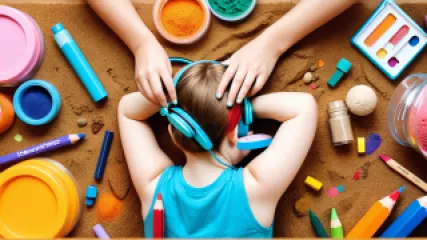The Ultimate Guide to Sensory Processing Activities
The Ultimate Guide to Sensory Processing Activities
Sensory processing is a fundamental aspect of our daily lives, yet it is often overlooked or misunderstood. Our ability to perceive and respond to the world around us through our senses is crucial for our physical, emotional, and cognitive well-being. In this comprehensive guide, we will explore the world of sensory processing and delve into a vast array of activities and strategies that can help individuals of all ages enhance their sensory experiences and improve their overall quality of life.
Understanding Sensory Processing
Sensory processing refers to the neurological process that allows our brains to receive, organize, and interpret the information we receive through our senses: sight, sound, touch, taste, and smell. This complex system plays a vital role in how we interact with our environment, regulate our emotions, and engage with the world around us.
For some individuals, however, sensory processing can be a challenge. Sensory Processing Disorder (SPD) is a condition in which the brain has difficulty receiving and responding to information from the senses. This can lead to a variety of issues, such as difficulty with coordination, emotional regulation, and social interactions.
Fortunately, there are a wide range of sensory processing activities and strategies that can help individuals, both with and without SPD, improve their sensory integration and overall well-being.
The Benefits of Sensory Processing Activities
Engaging in sensory processing activities can have a profound impact on an individual's physical, emotional, and cognitive well-being. Some of the key benefits include:
- Improved Emotional Regulation: Sensory activities can help individuals better understand and manage their emotions, leading to more positive and constructive emotional responses.
- Enhanced Concentration and Focus: By providing the brain with the sensory input it needs, sensory activities can improve an individual's ability to concentrate and focus on tasks.
- Increased Sensory Awareness: Engaging in sensory activities can heighten an individual's awareness of their senses, leading to a deeper understanding and appreciation of the world around them.
- Reduced Stress and Anxiety: Many sensory activities, such as deep breathing exercises and mindfulness practices, can help individuals manage stress and anxiety more effectively.
- Improved Motor Skills and Coordination: Sensory activities that involve movement and physical engagement can enhance an individual's motor skills and coordination.
Exploring Sensory Processing Activities
Now that we've established the importance of sensory processing and the benefits of engaging in related activities, let's dive into the various types of sensory processing activities you can incorporate into your daily life.
Visual Sensory Activities
Visual sensory activities focus on stimulating the sense of sight. These activities can involve exploring different colors, patterns, and visual textures, as well as engaging in tasks that require visual attention and coordination.
Some examples of visual sensory activities include:
- Coloring or drawing with a variety of art materials (e.g., colored pencils, markers, pastels)
- Observing and sketching natural elements, such as leaves, flowers, or insects
- Engaging in puzzles or mazes that challenge visual-spatial skills
- Exploring kaleidoscopes or other optical illusion toys
- Watching mesmerizing videos or animations that showcase vibrant colors and patterns
Auditory Sensory Activities
Auditory sensory activities focus on stimulating the sense of hearing. These activities can involve listening to a variety of sounds, creating music, or engaging in activities that require auditory processing and discrimination.
Some examples of auditory sensory activities include:
- Listening to soothing or calming music, nature sounds, or white noise
- Exploring different musical instruments and experimenting with sound creation
- Engaging in call-and-response games or rhythmic activities
- Participating in group singing or drumming sessions
- Listening to audiobooks or podcasts that captivate the imagination
Tactile Sensory Activities
Tactile sensory activities focus on stimulating the sense of touch. These activities can involve exploring different textures, materials, and physical sensations, as well as engaging in activities that require fine motor skills and hand-eye coordination.
Some examples of tactile sensory activities include:
- Engaging in sensory bin play with a variety of materials, such as sand, rice, or kinetic sand
- Exploring different fabrics, textures, and materials with the hands
- Participating in arts and crafts projects that involve various textures and materials
- Engaging in therapeutic massage or deep pressure touch activities
- Exploring fidget toys or other sensory-based manipulatives
Olfactory and Gustatory Sensory Activities
Olfactory and gustatory sensory activities focus on stimulating the senses of smell and taste, respectively. These activities can involve exploring a variety of scents, flavors, and sensations related to the olfactory and gustatory systems.
Some examples of olfactory and gustatory sensory activities include:
- Engaging in cooking or baking activities that involve a variety of spices, herbs, and flavors
- Exploring different essential oils or scented items and discussing their properties
- Participating in guided smell and taste tests, such as identifying different fruits or herbs
- Creating personalized scented items, such as candles or potpourri
- Incorporating mindfulness-based practices that focus on the olfactory and gustatory senses
Proprioceptive and Vestibular Sensory Activities
Proprioceptive and vestibular sensory activities focus on the senses of body awareness and movement, respectively. These activities can involve physical movement, deep pressure, and activities that challenge an individual's balance and coordination.
Some examples of proprioceptive and vestibular sensory activities include:
- Engaging in yoga, Pilates, or other mindful movement practices
- Participating in heavy work activities, such as pushing, pulling, or lifting objects
- Exploring various types of swinging, rocking, or spinning activities
- Engaging in obstacle courses or other gross motor activities that challenge balance and coordination
- Incorporating deep pressure touch, such as weighted blankets or compression vests
Incorporating Sensory Processing Activities into Daily Life
Integrating sensory processing activities into your daily routine can have a profound impact on your overall well-being. Here are some tips to help you incorporate these activities seamlessly:
- Assess Your Sensory Needs: Take the time to understand your own sensory preferences and needs. Pay attention to the activities, environments, or sensations that help you feel calm, focused, and engaged, as well as those that may be overwhelming or overstimulating.
- Create a Sensory-Friendly Environment: Tailor your living and working spaces to support your sensory needs. This might involve adjusting lighting, noise levels, or incorporating sensory-friendly decor and furnishings.
- Schedule Sensory Breaks: Regularly incorporate sensory processing activities into your daily routine, whether it's a few minutes of deep breathing exercises, a short walk in nature, or a quick session with a fidget toy.
- Experiment and Explore: Don't be afraid to try new sensory activities and find what works best for you. Be open to exploring a variety of experiences and be willing to adjust your approach as needed.
- Involve Others: Engage your family, friends, or colleagues in sensory processing activities. Sharing these experiences can foster deeper connections and understanding.
- Seek Professional Support: If you or a loved one is struggling with sensory processing challenges, consider consulting with an occupational therapist or other healthcare professional who specializes in sensory integration.
Cultivating Sensory Awareness and Well-Being
Embracing sensory processing activities is not just about addressing specific challenges or disorders; it's about cultivating a deeper awareness and appreciation for the richness of our sensory experiences. By engaging in these activities, we can enhance our overall well-being, improve our ability to regulate our emotions, and develop a greater understanding of ourselves and the world around us.
Remember, the journey of sensory processing is unique to each individual. Embrace the exploration, be patient with yourself, and trust that by nurturing your sensory awareness, you are investing in your physical, emotional, and cognitive well-being. The rewards of this journey can be truly transformative.
Conclusion
In this comprehensive guide, we have explored the fascinating world of sensory processing and the vast array of activities that can enhance our sensory experiences and overall well-being. From visual and auditory activities to tactile, olfactory, and vestibular experiences, the possibilities are endless.
Regardless of your age, background, or specific needs, incorporating sensory processing activities into your daily life can have a profound impact on your physical, emotional, and cognitive well-being. So, embrace the journey, explore the activities that resonate with you, and unlock the transformative power of sensory awareness.
Remember, the key to unlocking the full potential of sensory processing activities is to approach them with an open mind, a willingness to experiment, and a deep respect for your individual needs and preferences. By doing so, you can embark on a truly transformative journey towards greater self-understanding, emotional regulation, and overall well-being.
So, what are you waiting for? Start exploring the world of sensory processing activities and unlock the incredible benefits they have to offer. Your senses, and your overall well-being, will thank you.






